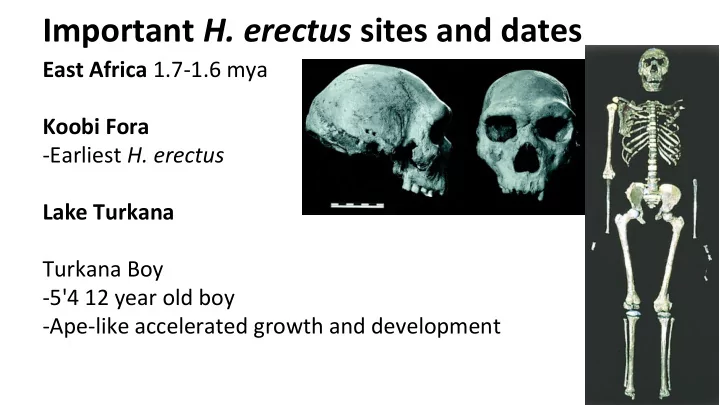

Important H. erectus sites and dates East Africa 1.7-1.6 mya Koobi Fora -Earliest H. erectus Lake Turkana Turkana Boy -5'4 12 year old boy -Ape-like accelerated growth and development 1
Important H. erectus sites and dates Out of Africa 1.7 mya Dmanisi, Rep of Georgia -First H. erectus out of Africa "Old man of Dmanisi" 2
Important Homo erectus sites and dates Asia 1.6-1 mya Java -Rapid migration (< 100,000 years) 3
Important Homo erectus sites and dates Asia (continued) 750-200 kya Zhoukoudian caves, China -45 individuals -100,000 artifacts (stone tools) 4
CHAPTER 10 5
Fire control 1 mya Wonderwerk cave, South Africa -Evidence of controlled fire use 6
Question: Why would using fire benefit us? -Warmth, protection, extends the day Cooking -Less energy to eat cooked meat AND beans, tubers, legumes -Safer and lasts longer (dry meat) -High-value source of calories to fuel energy-hogging brains 7
8
The Pleistocene Epoch 9
Pleistocene epoch 1.8 mya-10 kya The Ice Age Middle Pleistocene: 780-125 kya -Numerous glacial and interglacial s occurred -Climatic oscillations affected African, European, and Asian hominins Late Pleistocene: 125-10 kya -Last glaciations - Neandertal emerges in Europe 10
Middle Pleistocene African setting Interglacial periods: more rainfall Glacial periods: more arid 11
Middle Pleistocene European setting Interglacial periods: Open migration routes to Europe thru Eurasia Glacial periods: Colder and inaccessible to migrating hominins thru Eurasia 12
Homo heidelbergensis 850-200 kya Widely dispersed in Africa and Europe Morphological changes from Homo erectus -Increased brain size, rounded braincase 13
Late Pleistocene: 125-10 kya -Last glaciations -Neandertal emerges in Europe H. heidelbergensis in Europe gave rise to Neandertal H. heidelbergensis in Africa gave rise to Homo sapiens 14
Middle Pleistocene hominins (MPh) sites Europe 500-400 kya Atapuerca, Spain -80% of MPh remains found here -Evidence of early Neandertal transition 15
Middle Pleistocene culture -Still using Acheulian tools Levallois technique -More control over flake size/shape -Suggests increased cognitive capabilities 16
Middle Pleistocene hominin culture -Caves and open-air campsites -Made temporary structures Subsistence: increased variety in food resources: fruits, vegetables, seeds, nuts, eggs, and... Unique: marine resources: fish, mussels, shellfish, etc. 17
Middle Pleistocene hominins sites Africa 600 kya Bodo, Ethiopia -Earliest H. heidelbergensis site 18
Neandertal 130-30 kya 19
Neandertal -Most neandertal sites are in Europe 20
Neandertal morphology Cranial -Occipital bun CC=1520 cm 3 21
Neandertal morphology Postcranial -Robust, muscular, stockier -Shorter limbs Morphology = adaptations to colder European climate 22
Neandertal culture Mousterian tool industry (125-40 kya) -More flake tools vs core tools -Tools for skinning and making clothes -Regular fire use 23
Recommend
More recommend